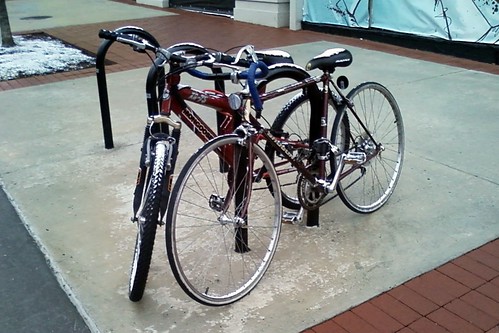Another novelty is the duplex wheel [that is, bicycle - with side-by-side seating], with the Maxim rapid-firing gun mounted upon it. It carries two riders, one to propel the machine and the other to work the gun. It is understood that a proposition has been made to the representatives of the Cuban government to equip a regiment of their soldiers with these machines, it being shown that with proper handling they would prove awful and effective engines of destruction.Unfortunately no illustration of this bicycle was included and I have had no luck finding one elsewhere. The machine-gun equipped bike didn't seem to prosper as a tool of war.
When the first diamond frame bicycles became popular in the 1890s they were often called "wheels" - the national cycling association was called the "League of American Wheelmen." We have moved from "wheels" to "bikes," but the bicycles have remained remarkably the same over more than 100 years - elegant in their efficiency and simplicity. And many of the issues that we think are new? They were around then too.
Thursday, March 31, 2011
Maxim Gun Equipped Bicycles (1896)
Part of an article about a bicycle show in Washington DC - the article is in the Washington D.C. "Morning Times, March 26, 1896 issue.
Monday, March 28, 2011
The Woman Cyclist - 1896 Article
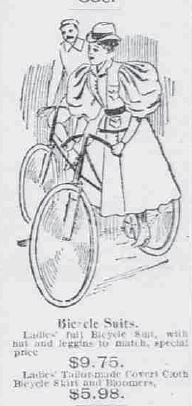
Ad for "bicycle suit" for women cyclists, 1896
Text from an article in the Washington DC Morning Times, June 7, 1896.
THE WOMAN CYCLIST.And finally this ~
She Reigns Supreme This Season. Some Timely Suggestions for Her.
The woman cyclist reigns this season. The number of women who have taken to the wheel shows an increase of 75 percent, and the makers of machines for women can scarcely keep pace with their orders.
In the selection of a machine most women who are making their debut as riders this reason need reliable wholesome advice, and if any points of value are secured from this article its purpose will have been fulfilled.
So far as the costume is concerned, knickers are very largely worn in Europe, especially in Paris, but in America they are the exception more than the rule, and therefore this is addressed to ladies who will ride in skirts.
The question of weight in connection with ladies' machines has recently received more attention at the hands of manufacturers than ever before, and the consequence is reliable machines may now be purchased, fitted with brake, mud guards, dress-guard, and gear-case at just about thirty pounds in weight.
In selecting a machine a lady should see that the handle bars and saddle can be so adjusted as to enable her to sit perfectly upright, for nothing looks much worse than to see a lady adopting what is known as the "scorcher" attitude.
Large makers build machines in more than one size, and exceptionally short and exceptionally tall ladies should have machines built higher and lower respectively in the frames than standard patterns.
The pedals should be rubber, and not all steel, the latter with their sharp points being more liable to catch in the rider's dress, pedals to suit the width of foot, can, of course, be selected.
A really first class-machine by a leading firm will cost nearly $lOO, or perhaps a little more, but, of course, very good machines can be purchased for less than that amount.
There are several little things a tider should be particularly careful about, and one of these is the application of the brake. The brakes fitted are usually those which act on the tire, and should consequently not be too suddenly applied, or they will probably tear the tire.
A lady will find it very convenient to mount from the curb, and will thus be enabled to properly arrange her dress. Sometimes this method of mounting is impossible. A lady will then do well to allow one of the pedals to ascend to its fullest height and descend the merest trifle, and then, placing one foot on the pedal in question, spring into the saddle, the weight of her body on the pedal necessarily causing the machine to go forward. When well going it will only be necessary to slightly raise herself in the saddle, actually standing on the pedals, and the dress will fall as it should. This will be found to be a perfectly easy accomplishment with a little practice.Full article as PDF is here.
Sunday, March 27, 2011
Bikes that Live Outside & Snow
Saturday, March 26, 2011
Cross Country Cycle Road - 1896 Plan

Map for a cross country bicycle route
Taken from Washington DC Morning Times, June 7, 1896. Reflects some wishful thinking on the future of cycling in the days before automobile owners (and their allies) took over the lead in advocating for funding a good network of roads. The article's author advocates a connected network of "good roads" rather than more expensive macadamized (asphalt) dedicated "bicycle tracks" or "bicycle paths" for long distance bicycle travel.
Some quotes ~
To establish a bicycle track from coast to coast so that wheelmen can journey from New York to San Francisco as easily if not as rapidly as they now do by train. Such tours have been undertaken and partlv carried out. One man would wheel from Salt Lake Cit to Buffalo. Another, at some time, would start at Chicago and wheel to the Pacific Coast. But they seldom wanted to take the trip twice. It was too tiresome. Roads were too bad. Too many mountain paths had to be climbed, too many prairies tortured through. But I am looking into the matter so as to do away with all this.
What has hampered us more than anything in this cross country project are the wheeling [cycling] enthusiasts. These gentlemen insist upon bicycle paths and so we get nothing. A macadamized bicycle path costs in a rocky locality $15,000 per mile. Now make this same locality and use tho road that is already in it by merely improving it and the cost will not be $3,000. You can make a mile or very bad road into very good road for that sum. That is what I mean by intelligent wheeling legislation.
"Across the country in eighty days will be the wheelman's attraction a few years hence. Now it looks funny, but that is what Jules Verne's idea or "Round the World In Eighty Days" did to people years ago. Now we can belt the sphere in seventy days."Full text of article available most readably here.
Saturday, March 19, 2011
108 Links, Half Inch of Stretch (Full Link)
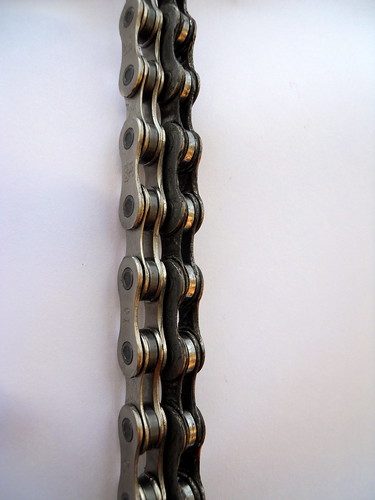
New chain and old chain match up for while, more or less
On the left is a new SRAM chain for my Traitor Ruben, on the right is the original SRAM chain after (?) 3,000 miles (I guess). Turns out the original chain is the 1030model, which is the least expensive 10 speed chain they have (and stretches the fastest, it seems). Since my "good" road bike has a Shimano CN-6600 10 speed chain that hasn't stretched yet, after more like 5,000 miles, I was quite surprised to realize (a) that this was a cheap chain, and (b) that it has stretched a lot.

Over the full length of the chain, full link worth of stretch
The chain has 108 links (one half inch per link, when installed - total of 54 inches) plus a "power link" to hook the ends together. After however many miles I have gone, the chain is now one full link (one half inch) longer overall. Should have replaced it a while ago! To slow down this problem, I bought a better grade of SRAM ten speed chain to replace it.
It isn't the chain plates that stretch, of course, but the pins inside that bend. I don't think this caused the cogs or rings significant damage. Hmm . . .
Small Things Can Be Problems
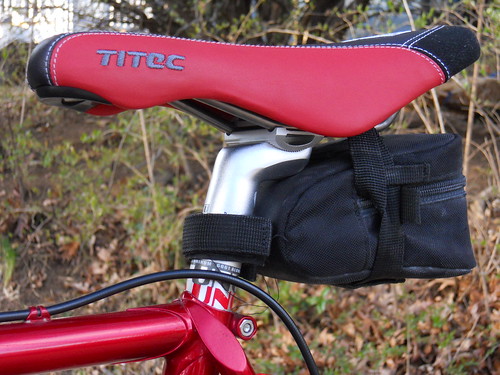
Troublesome underseat toolbag
Over time it becomes clear that even small purchases of items that should be straightforward can be problematic. There are various choices for underseat toolbags, but they are all basically the same idea - carry an extra tube, a multitool, perhaps a flat kit as well and I also have a couple of my favorite Allen wrenches.
While the bag shown above looks fine, after I used a wrench in it last, in closing it the zipper came off. Once I open it again (it is presently stuck closed) that's the end of that. A previous bag with an Allen wrench got a hole where apparently the wrench constantly rubbed - I found the wrench attempting to escape before it got away, fortunately. Buying toolbags is getting habit forming!
A possible solution I suppose is to buy a leather Brooks Saddles Challenge Tool Bag for ~$90 or so. No, that isn't going to happen. Hmm. . .
Friday, March 18, 2011
Detour Closed; Bike Trail Restored
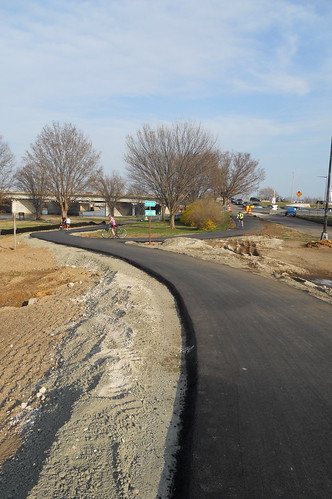
The newly restored bike trail, from the new approach to the Humpback bridge
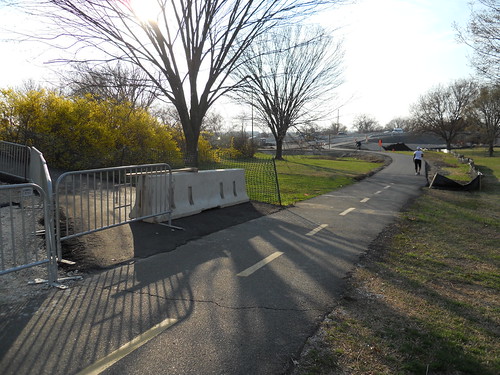
Detour is closed, new routing (much like the old) is restored with new asphalt
The new asphalt already continues across the new bike portion of the Humpback bridge.
I didn't take anyone's photo, but an amazing number of people ignored the open trail in front of them and slowed to turn up the detour and couldn't figure out that all they had to do was . . . continue up the open trail in front of them. Habit forms quickly, I guess.
Thursday, March 17, 2011
Riding 1982 Bridgestone Sirius
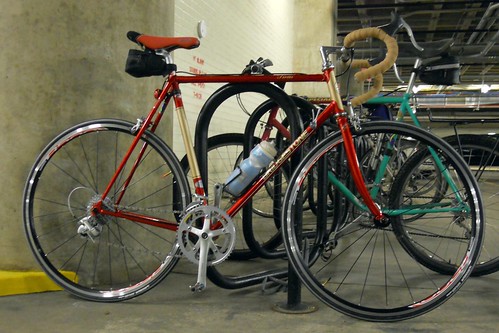
Completed Bridgestone Sirius bike in Madison building garage (where I work)
I bought the frame, fork and bottom bracket on eBay for a 1982 Bridgestone Sirius road bike. It is a lugged steel frame, size 56 cm. The frame was like 85 dollars plus shipping. The paint is in better shape than the seller's photo showed it on eBay.

Nitto Olympiade handlebars, purchased on eBay
I was not going to try to create a "PC" (period correct) 1982 bicycle - I wanted to see if I could buy and assemble a pleasing ride with components from various years for around $500 or so. (The joke was that for $500 I would put together a bike that I could easily sell for $350.)
Still, some things I did more or less PC - since the bike requires a quill stem for the threaded headset, I got Nitto Olympiade handlebars that are similar to what the bike came with (it had Nitto Universiade bars - close enough). I found someone selling these handlebars along with an SR stem (same period) at a good price (around 25 dollars for both) and stopped looking for the Nitto Technomic A stem the thing came with.
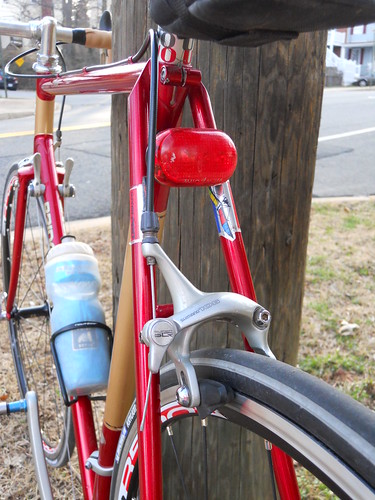
View from the rear - "flamboyant red" paint (per catalog)
I got a Shimano 1055 series 105 group, although it didn't include the cogs (in back). So the brakes, brake levers, the stem shift levers, front and back derailleurs, and cranks and rings are all Shimano 105 from 1990 give or take. Intended to work with seven cog cassette. (The bike came with a six cog freewheel and most of what is now Shimano was originally SunTour.) The cog and ring tooth numbers are completely different than what this had originally -
Before - front, 52 x 42 teeth; now 53 x 39 teeth
Before - back, 14, 16, 18, 21, 24, 28 teeth; now 11, 13, 15, 18, 21, 24, 28 teeth
So nominally this makes it faster. Also, it came with 25 mm tires and these are 23, but now of course people are all over the place as to whether narrower tires are faster or not.

Seven cogs should be enough
Some things I bought new. The Shimano HG-70 cassette (with seven cogs) I bought new. The bike was sold originally with six cogs and apparently the "standard" was to have a space for the rear wheel 126 mm wide - when the increase was made to eight cogs (and now up to 11) the typical (or "standard") width was increased to 130 mm. So I had to buy a 4 mm spacer so that the set of seven cogs don't have too long (big) a cassette space to occupy (and slide back and forth - not good!). I decided not to try to find a 126 mm wide wheel so I simply spread the 126 mm wide opening of the rear stays to force in the 130 mm wide wheel with cassette. Four mm is not a problem for this "brute force" approach, it seems. Or so people advise on the Internet. So far so good.
I also bought a new aluminum seatpost and a (relatively) cheap new seat (but in red to match the paint!). I mismeasured, thought the opening was a standard 27.2 mm and bought a seatpost that didn't fit. Had to buy a 27.0 mm diameter seatpost - it fits. Not terribly attractive, but the choices in this size were few. In fact, I was a little concerned until I did find one that there was no such thing and that for lack of a seatpost the bike was going to be unfinished.
I got a new SRAM 870 chain. This is a chain intended for use with either 7, 8 or 9cogs (which are all the same width, it seems). Compared to a ten speed chain, it looks incredibly wide, which is sort of funny (to me).
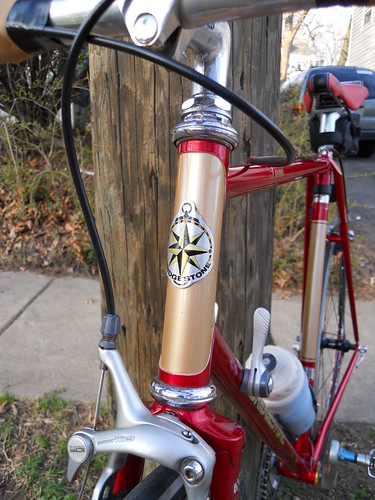
Italian cut head lug (according to the 1982 catalog)
The frame is ChroMo tubing with Tange steel lugs. The headset is also from Tange.
The shift levers look more "old school" than they really are - the right one is actually "variable" - you can choose between indexed shifting or friction shifting. I have been using the indexed shifting option and it works well. The left one is friction shifting for the front derailleur.
I found brake and shift lever Shimano cable "kits" rather than buying lots of cable and housing and cutting to length. This worked fine, which surprised me for some reason. Some Jagwire replacement cables are pretty expensive but these were less then eight dollars each.
The wheels are new - Shimano R500 wheels that I found on sale (Presidents Day holiday) for $150 with free shipping. The wheels are the single most expensive purchase made for this - much more (relatively speaking) than the frame.
Oddly the original brake caliper slots for the brake pads were longer, the brake pads with these newer 105 brake calipers just barely make it onto the wheel rims properly; I will probably file out the slot holes so that they can be moved a little to do a better job of gripping the rims. This I suppose is the problem with choosing parts from different eras in bike production practices.
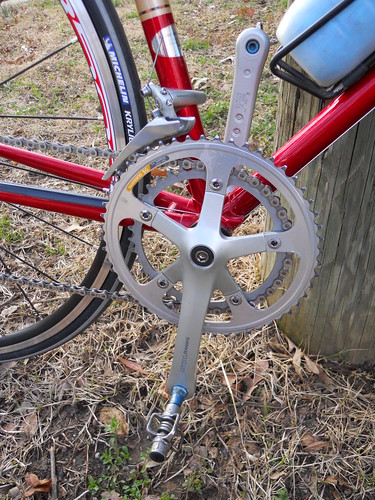
The Shimano 105 rings and cranks (pedal arms)
One change for me is that my other bikes have 172.5 mm long crank arms - these are slightly shorter at 170.0 mm. 170 is more typical of a (slightly) smaller bike. I don't have particularly long legs, so perhaps this is good?
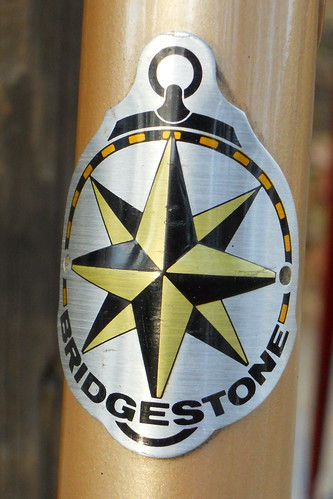
Bridgestone company nameplate on headtube
Summary - the assembly of the parts (in effect, attaching to the frame in various ways) was not particularly difficult - the complex part was figuring out which parts from which periods would work together and also trying to order only parts that would fit with whatever had been purchased already. Not sure why, but it was quite enjoyable and best of all, the bike is fun to ride and looks lovely (says I). Getting used to the different shifters is a challenge but that's OK.
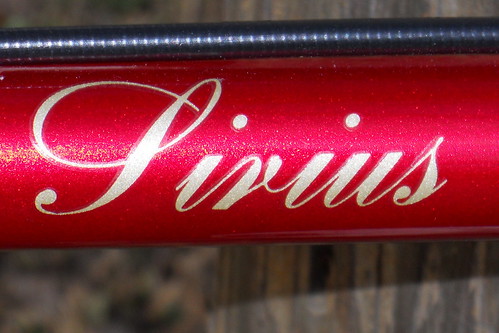
Friday, March 11, 2011
Four Mile Run Floods Bike Path
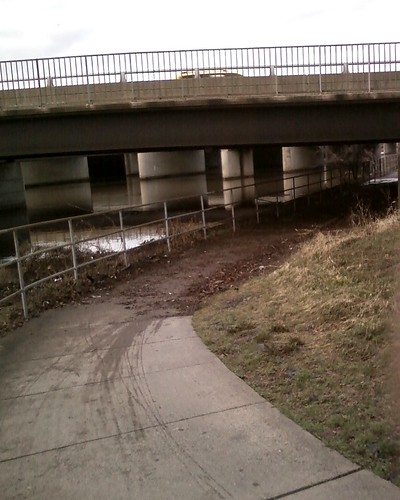
Taken with new phone's camera - slightly better than previous phone camera
Four Mile Run went up over the bike trail due to heavy rain, leaving debris on trail. I stopped and pushed the worst of it off the trail - although not so clear I did anything in this photo! I was "sweeping" with a board that had floated onto the trail, so not very neat. Still, I got the big bits and pieces off the bike path.
Since this is right around a curve, someone could have a problem if they came around the corner at a moderate speed into this the way it was.
Sunday, March 6, 2011
Riding in the Rain (with Umbrella)
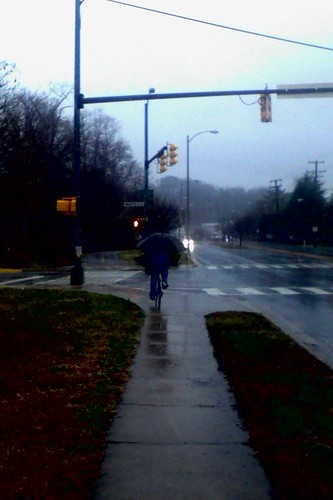
Seen while walking the dog, Sunday morning
This fellow was slowly making his way on the sidewalk, umbrella in hand, early Sunday morning as I was walking the dog. I have seen this in photos of people riding in the Netherlands but a little unusual here. Presumably he was on his way to work and probably wishing he had a car. Some cycle riders I see pretty clearly would prefer that transportation option.
Poor quality of photo result of poor quality of camera in cheap phone, alas.
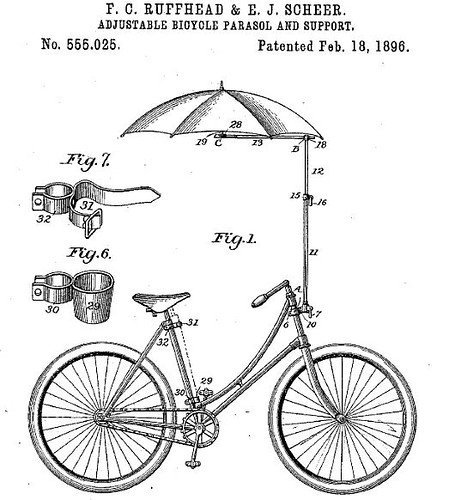
What the fellow needed, I suppose - patent application made in 1896
Saturday, March 5, 2011
1896 Map of Washington "Bicycle Tours"

PDF of this newspaper page provides the best image quality and ability to zoom in. Given that this image is from microfilm of the original (that is, several times reformatted from the original paper item) the quality is pretty good. Not great, but good.
From the article below the map ~
There has never been a season when there was half as much travel on the flying wheel as there has been, is, and is going to continue to be this season.and
Not a night passes but some gay party passes out for a run through the country. All routes are being tried and becoming better known, so that even the inexperienced, with the assistance of a map and a little information from a friend can make pleasant and health-giving trips into the open country.The article goes on to provide descriptions of different possible excursions.
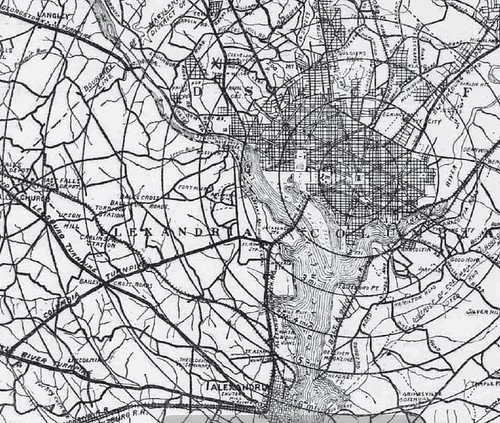
Above, somewhat more detailed view of the Northern Virginia part of the map; below, zooming in further
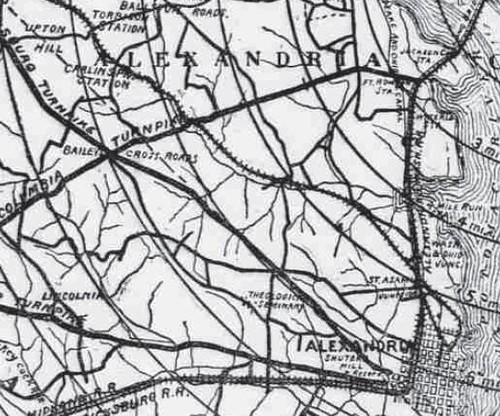
Already in 1896 bicycle rentals were available ~
Escape from the heat and air of the city for a few hours a day is possible to every person who cares to learn to ride and can get the small amount necessary to hire a wheel - it is of course better to own one, but no longer absolutely necessary.
Japanese Bicycles, 1896
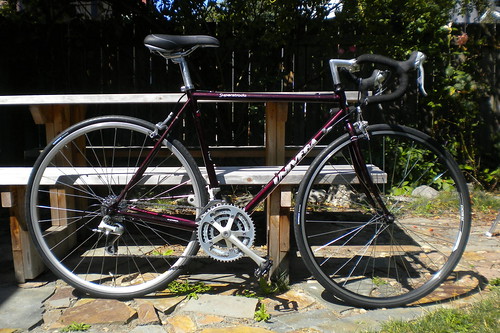
A Japanese bike from 100 years later than the two articles below
Short article about Japanese bicycle industry in 1896, from the Morning Times of Washington DC, September 13, 1896
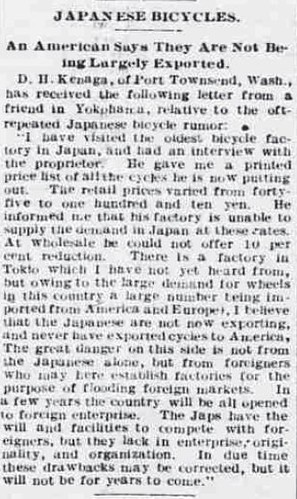
JAPANESE BICYCLES.In 1897, the Yen was worth about fifty cents to the U.S. dollar according to a Wikipedia article. So these prices were (in theory) about half the U.S. range for bicycles at the time.
An American Says They Are Not Being Largely Exported.
D. H. Kenaga of Port Townsend, Wash., has received the following letter from a friend in Yokohama, related to the oft repeated Japanese bicycle rumor:
"I have visited the oldest bicycle factory in Japan, and had an interview with the proprietor. He gave me a printed price list of all the cycles he is now putting out. The retail prices varied from forty five to one hundred and ten Yen. He informed me that his factory is unable to supply the demand iu Japan at these rates. At wholesale he could not offer 10 per cent reduction. There is a factory in Tokio which I have not yet heard from, but owing to the large demand for wheels in this country a large number being imported from America and Europe, I believe that the Japanese are not now exporting, and never have exported cycles to America. The great danger on this side is not from the Japanese alone, but from foreigners who may establish factories for the purpose of flooding foreign markets. In a few years the country will be all opened to foreign enterprise. The Japs [sic] have the will and facilities to compete with foreigners, but they lack in enterprise, originality,
and organization. In due time these drawbacks may be corrected, but it will not be for years to come."
Thus it would seem that at this early period of industrial production in Japan there was a concern in the U.S. that inexpensive Japanese bicycles could or would flood the American market. (Presumably that potential flood is what is meant by "oft repeated Japanese bicycle rumor," above in bold.)
Short piece in the magazine "Cycling Life" for bicycle tradesmen, 1896

JAPANESE BICYCLES.This author does not seem concerned about imports of Japanese bicycles to the U.S. but rather interested in trade heading the other direction. From time to time Cycling Life would report export figures of bicycles to different countries, including Japan, although by today's standards the figures would generally seem modest, Japan was generally in the top half.
Yokohama, Japan, Oct. 9.—There are at present four bicycle workshops of note in Japan, two in Tokyo, one in Kyoto and one in this city. All were opened some three or four years since. Kajiuo's workshops in Yokohama and Sasaki's in Asabu, Tokyo, being the pioneers. One other big workshop is that of Morita, in Honjo, Tokyo. The output of each shop does not exceed 130 machines, 17 mechanics being employed in one, and only 10 in another. They are not adepts at the work. At present many different kinds of bicycles, are manufactured in the workshops of Tokyo and elsewhere, the price of the machines varying very much. A pneumatic tire machine of the first-class from the Morita factory costs $58.92, a second machine $49.10, but one of special make costs $73.05 The pneumatic tire being difficult to repair, is not in favor with Japanese riders, who prefer substance to fashion. They like the solid tired bicycle, which costs less to keep in repair The latter sell for a first-class machine at $51.50; second class, $46.64; third class, $39 GS and fourth class at $34.39. The high, thin tired machines, though much more in vogue formerly, are not now so popular. Their price is comparatively low, a first-class machine costing $31.15, a second-class one $27 and a third-class one $22. Both the Tokyo shops are patronized by the post office and one is under the patronage of the metropolitan police. Generally speaking, bicycle riding is not so popular in Tokyo as in Yokohama riders of that city being confined to employees of mercantile and banking corporations, head clerks of large shops and school teachers. In Tokyo the home-made machine and foreign makes are closely balanced in point of numbers. With the increase of riders the patronage accorded to Japanese machines is on the increase.
Subscribe to:
Posts (Atom)
